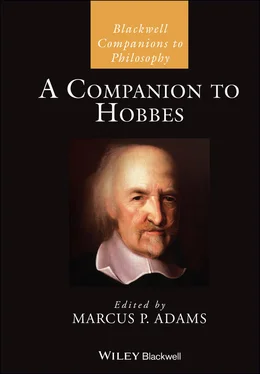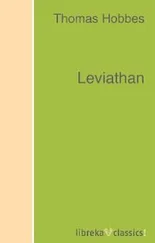The section that follows Hobbes’s etymological tracing of “demonstration” back to the ancient Greek geometrical term reveals a different sense of “demonstration”:
It is proper to methodical demonstration, First, that there be a true succession of one reason to another, according to the rules of syllogizing delivered above.
Secondly, that the premises of all syllogisms be demonstrated from the first definitions.
(EW I.87)
The formal definition of “demonstration” Hobbes gives just before he invokes its ancient origins confirms that it is “a syllogism, or series of syllogisms, derived and continued, from the definitions of names, to the last conclusion” (EW I.86). Hobbes’s recounting of the ancient geometrical sense of “demonstration” is thus a historical side bar to motivate putting geometry at the foundation of scientific knowledge by appeal to the ancients. Once geometry makes visible its foundational definitions, scientific reasoning proceeds syllogistically.
The rhetorical purposes of the watch and automaton analogies, combined with Hobbes’s formal definitions of scientific knowledge and “demonstration” caution against taking mechanistic resolution and re-composition as Hobbes’s method for civil science. 14Nonetheless, De corpore’s analogy between all definitions and geometrical ones reinforces the impression that Hobbes’s method of demonstration is one of construction:
But definitions of things, which may be understood to have some cause, must consist of such names as express the cause or manner of their generation, as when we define a circle to be a figure made by the circumduction of a straight line in a plane, & c.
(EW I.81–2)
But Hobbes also affirms the Scholastic view that principles are indemonstrable, adding that there are no principles aside from definitions (EW I.80, 82). Properly speaking, definitions are not demonstrated; hence their generation is not scientific ratiocination or computation. So, though one might make visible the definitions of natural and civil philosophy in a way that parallels geometrical construction of a figure, this is only a demonstration in a loose, analogous sense. Hobbes’s analogies thus do not support the bifurcation into a demonstrative method of construction in civil science versus the physicist’s method.
With this confusion removed, can we now articulate a unified method that would legitimize Hobbes’s claim to inaugurate a moral science based on the true foundations of natural philosophy? Even having restricted scientific knowledge derived from the primary geometrical definitions to Hobbes’s narrow sense of propter quid demonstrations, this remains challenging. If the success of Hobbes’s project rests on the capacity of his method to provide a true foundation of definitions or principles about universal causes from which, through a unified chain of syllogisms, ever more specific and complex effects are deduced, then it seems to fail. Notwithstanding that all scientific knowledge is knowledge of bodies, there are key differences between the aspects of body that each individual science takes as its object.
Natural philosophy scientifically knows what follows from the accidents of natural bodies whereas civil philosophy scientifically knows what follows from the accidents of the artificial body that is the commonwealth. Within natural philosophy, geometry, which lies at the base of the hierarchy in De corpore , takes as its object the accidents common to all bodies whereas physics takes as its object qualities, i.e., accidents of bodies as sensed by humans. This implies that the application of Hobbes’s generic method varies with object. As scholars have long realized, Hobbes’s actual procedure in physics differs from that of geometry and civil science since we are not privy to the underlying causes of the bodily qualities we sense. 15In physics one cannot define a quality by mentally constructing it, as one does with the generative definition of a square or when one imagines a commonwealth coming into being. Rather one must begin from observed effects, like the reddish hue of the setting sun or the passion of joy we feel when we watch it, and reason hypothetically to their possible causes. Since physics lies in the middle of the hierarchy of scientific knowledge providing the bridge between geometry and practical philosophy, if one assumes that unity means the sciences present a unified content, via an axiomatic-deductive method whereby all their conclusions trace back through a seamless chain of deduction to the same foundational definitions, then the divergent methodical procedure necessitated by the objects of physics appears to disrupt the unity of the whole.
In the face of these problems, one can 1) deny that Hobbes maintains a unity of theoretical and practical philosophy or 2) affirm a looser unity by denying that it is conditioned upon an axiomatic-deductive method. Advocates of 2) present evidence of Hobbes’s commitment to a non-deductivist unity. I draw on two recent views of this unity to propose a third. 2a) reads Hobbes’s sciences as unified not by a systematic content ultimately deduced from first principles, but by a common “demonstrative” method analogous to the geometrical method of construction. 16This strikes me as the correct strategy; however, though one finds procedures resembling constructions throughout Hobbes’s works, they cannot, as per his formal definitions constitute scientific demonstrations. Hence though they loosely connect practical philosophy with geometrical procedures, they cannot account for a moral science in Hobbes’s sense. 2a) also excludes physics from science. 2b) holds that Hobbes maintains the possibility of scientifically deducing a consistent body of theoretical and practical knowledge from first principles but includes alternative starting points and methods for non-philosophers to gain knowledge of practical philosophy. 17This too is promising, but to the extent that there is one method, it is an ideal that does no work. In practice, Hobbes proceeds as though physics and politics are independent domains with their own methods.
Despite these problems, 2) is better supported than 1). Hobbes’s view of scientific knowledge and generic definition of method point to one type of cognitive activity that constitutes scientific knowledge of all philosophical subjects. Regardless of whether one studies natural or artificial bodies, starts from cognitions of causes or effects, formal definitions or true cognitions attained by introspection, the process of methodical computation that charts the shortest route between causes and effects should be identical. This fits Hobbes’s aim of inaugurating a civil science to exorcise the Scholastic philosophy Empusa. Absent a unity of method for science, the boundaries between practical philosophy and religion will blur as non-scientific forms of cognition can then be invoked to confuse the rights and duties of subjects. Hobbes’s approach to identifying and removing the source of civil strife then falls apart. Hence overall 2) is the correct approach. I now draw on Hobbes’s context to propose a third variation, 2c).
Key is recognizing that Hobbes’s generic definition of method is just that. He next distinguishes method into what his contemporaries call universal method versus a method of proof for solving particular problems, known as particular method. Universal method was typically a preliminary hierarchical ordering of the concepts and definitions required for the discovery or teaching of knowledge of a subject, or both. It is distinct from method as a set of rules for scientific proofs, as found in Aristotle’s Posterior Analytics . 18Nonetheless, the two methods go hand in hand since universal method provides the systematic framework within which one generates different kinds of proofs by the particular method. This provides a third kind of unity for all scientific knowledge, rooted in method, with universal method providing a hierarchically ordered set of principles and definitions one requires as starting points for the deductive arguments one then makes in different domains to answer particular questions. Interpretation, 2c), allows for one computational activity that unifies all the sciences: namely, the rules of syllogistic reasoning for making valid propter quid demonstrations once one has the true principles, and applies the relevant definitions to the problem at hand. But to avoid willy-nilly attempts at deduction from any definitions, Hobbes’s method includes a preliminary methodical resolution of ideas and orderly composition into definitions, starting from the simplest concepts of geometry. This ensures unity at the level of first principles and the definitions one is permitted to take as starting points for scientific demonstrations at each level of inquiry. 2c) has been overlooked because just as Hobbes uses “demonstration” equivocally, he characterizes both activities as “computation” and labels methodical procedures that make up both the ordering computation and the syllogizing computation as analysis and synthesis. 19The two branches of method have thus been confused for one. I now disentangle them.
Читать дальше












